SITHKOP001 Clean and Sanitize: Written Questions, Quiz Solution Guide
VerifiedAdded on 2023/07/17
|9
|1582
|239
Homework Assignment
AI Summary
This assignment solution by Jennifer Pinzon for the course Certificate III, unit SITHKOP001, focuses on cleaning and sanitizing in a commercial kitchen setting. It includes answers to written questions covering definitions of cleaning and sanitizing, safe chemical handling, cleaning schedules, waste management, energy and water conservation, and cross-contamination prevention. The solution also addresses numeracy problems related to detergent and sanitizer dilution ratios, linen identification in a restaurant, and a quiz covering topics such as PPE usage, first aid for chemical spills, waste systems, chemical storage, pest control, and utensil cleaning. The assignment concludes with a project involving the correct storage of cleaning equipment and kitchen items, emphasizing safety and hygiene practices.
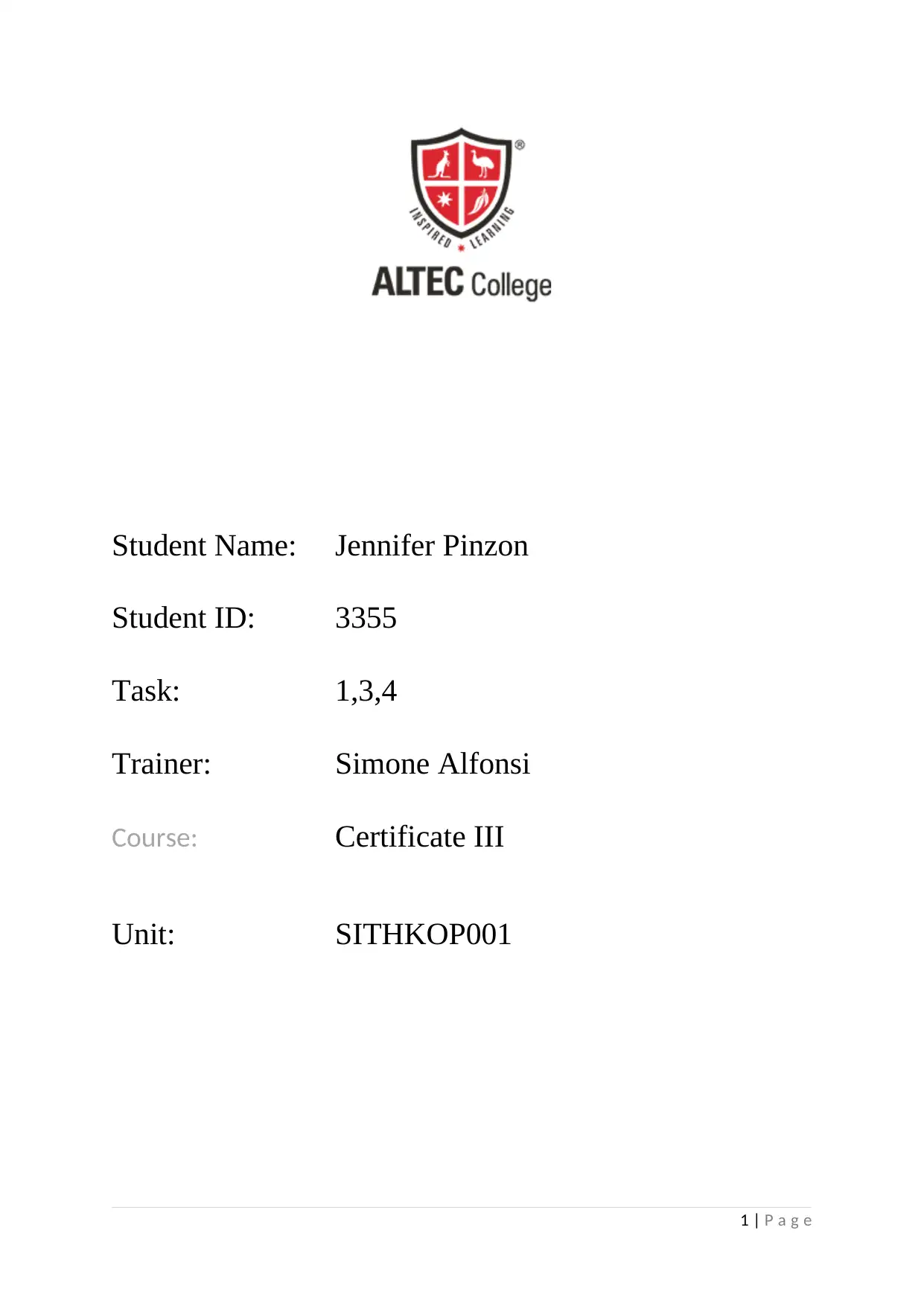
Student Name: Jennifer Pinzon
Student ID: 3355
Task: 1,3,4
Trainer: Simone Alfonsi
Course: Certificate III
Unit: SITHKOP001
1 | P a g e
Student ID: 3355
Task: 1,3,4
Trainer: Simone Alfonsi
Course: Certificate III
Unit: SITHKOP001
1 | P a g e
Paraphrase This Document
Need a fresh take? Get an instant paraphrase of this document with our AI Paraphraser
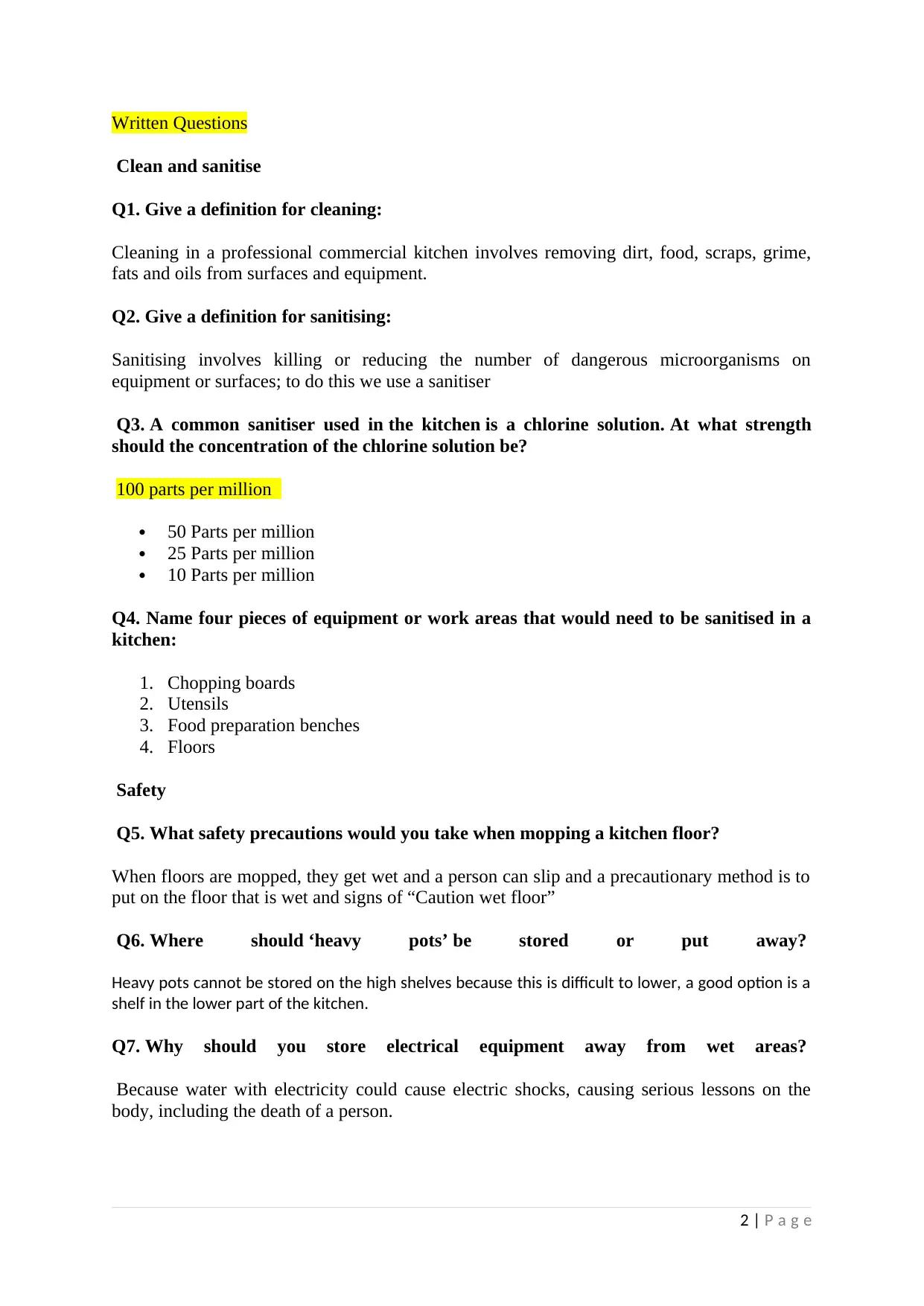
Written Questions
Clean and sanitise
Q1. Give a definition for cleaning:
Cleaning in a professional commercial kitchen involves removing dirt, food, scraps, grime,
fats and oils from surfaces and equipment.
Q2. Give a definition for sanitising:
Sanitising involves killing or reducing the number of dangerous microorganisms on
equipment or surfaces; to do this we use a sanitiser
Q3. A common sanitiser used in the kitchen is a chlorine solution. At what strength
should the concentration of the chlorine solution be?
100 parts per million
50 Parts per million
25 Parts per million
10 Parts per million
Q4. Name four pieces of equipment or work areas that would need to be sanitised in a
kitchen:
1. Chopping boards
2. Utensils
3. Food preparation benches
4. Floors
Safety
Q5. What safety precautions would you take when mopping a kitchen floor?
When floors are mopped, they get wet and a person can slip and a precautionary method is to
put on the floor that is wet and signs of “Caution wet floor”
Q6. Where should ‘heavy pots’ be stored or put away?
Heavy pots cannot be stored on the high shelves because this is difficult to lower, a good option is a
shelf in the lower part of the kitchen.
Q7. Why should you store electrical equipment away from wet areas?
Because water with electricity could cause electric shocks, causing serious lessons on the
body, including the death of a person.
2 | P a g e
Clean and sanitise
Q1. Give a definition for cleaning:
Cleaning in a professional commercial kitchen involves removing dirt, food, scraps, grime,
fats and oils from surfaces and equipment.
Q2. Give a definition for sanitising:
Sanitising involves killing or reducing the number of dangerous microorganisms on
equipment or surfaces; to do this we use a sanitiser
Q3. A common sanitiser used in the kitchen is a chlorine solution. At what strength
should the concentration of the chlorine solution be?
100 parts per million
50 Parts per million
25 Parts per million
10 Parts per million
Q4. Name four pieces of equipment or work areas that would need to be sanitised in a
kitchen:
1. Chopping boards
2. Utensils
3. Food preparation benches
4. Floors
Safety
Q5. What safety precautions would you take when mopping a kitchen floor?
When floors are mopped, they get wet and a person can slip and a precautionary method is to
put on the floor that is wet and signs of “Caution wet floor”
Q6. Where should ‘heavy pots’ be stored or put away?
Heavy pots cannot be stored on the high shelves because this is difficult to lower, a good option is a
shelf in the lower part of the kitchen.
Q7. Why should you store electrical equipment away from wet areas?
Because water with electricity could cause electric shocks, causing serious lessons on the
body, including the death of a person.
2 | P a g e
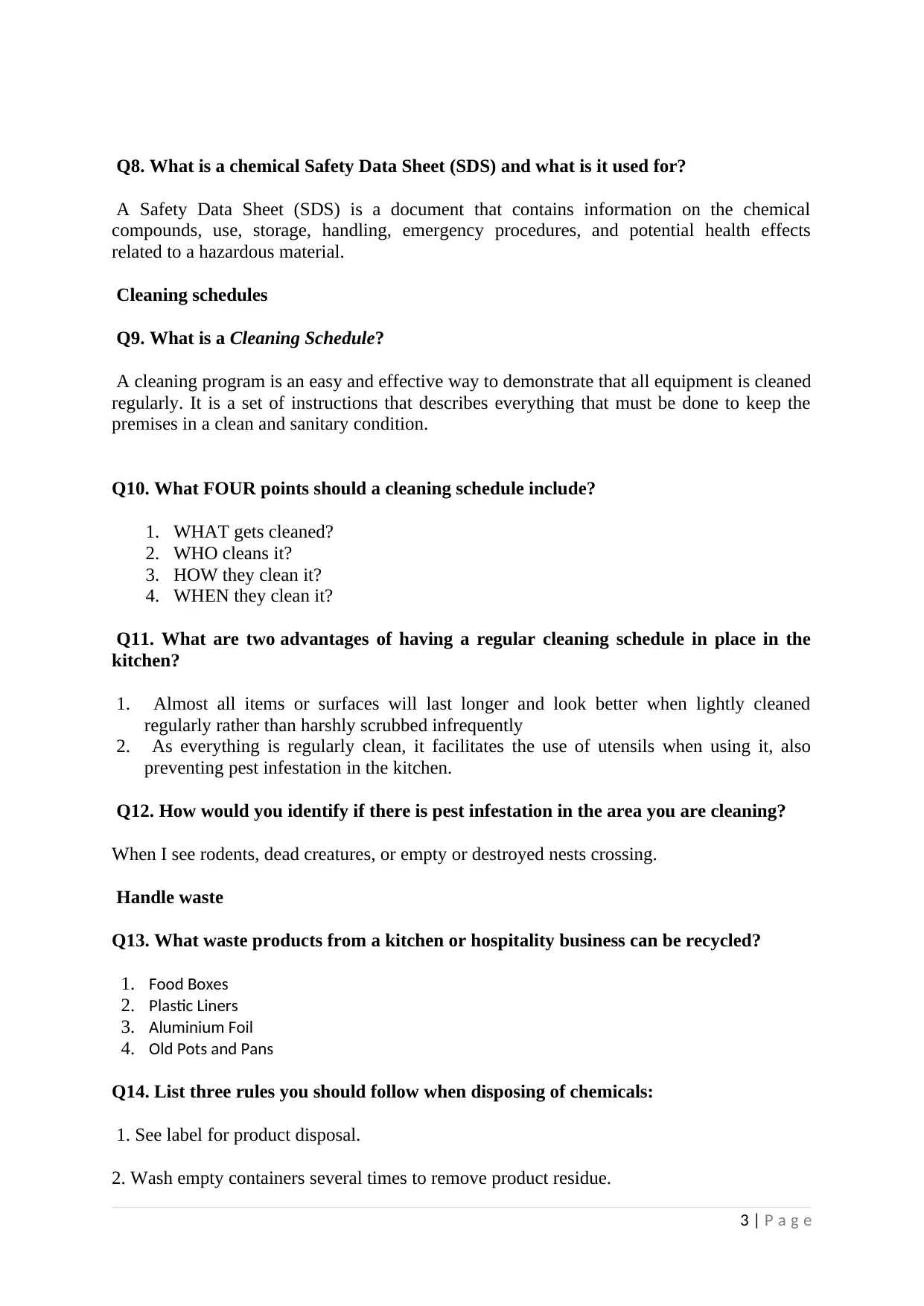
Q8. What is a chemical Safety Data Sheet (SDS) and what is it used for?
A Safety Data Sheet (SDS) is a document that contains information on the chemical
compounds, use, storage, handling, emergency procedures, and potential health effects
related to a hazardous material.
Cleaning schedules
Q9. What is a Cleaning Schedule?
A cleaning program is an easy and effective way to demonstrate that all equipment is cleaned
regularly. It is a set of instructions that describes everything that must be done to keep the
premises in a clean and sanitary condition.
Q10. What FOUR points should a cleaning schedule include?
1. WHAT gets cleaned?
2. WHO cleans it?
3. HOW they clean it?
4. WHEN they clean it?
Q11. What are two advantages of having a regular cleaning schedule in place in the
kitchen?
1. Almost all items or surfaces will last longer and look better when lightly cleaned
regularly rather than harshly scrubbed infrequently
2. As everything is regularly clean, it facilitates the use of utensils when using it, also
preventing pest infestation in the kitchen.
Q12. How would you identify if there is pest infestation in the area you are cleaning?
When I see rodents, dead creatures, or empty or destroyed nests crossing.
Handle waste
Q13. What waste products from a kitchen or hospitality business can be recycled?
1. Food Boxes
2. Plastic Liners
3. Aluminium Foil
4. Old Pots and Pans
Q14. List three rules you should follow when disposing of chemicals:
1. See label for product disposal.
2. Wash empty containers several times to remove product residue.
3 | P a g e
A Safety Data Sheet (SDS) is a document that contains information on the chemical
compounds, use, storage, handling, emergency procedures, and potential health effects
related to a hazardous material.
Cleaning schedules
Q9. What is a Cleaning Schedule?
A cleaning program is an easy and effective way to demonstrate that all equipment is cleaned
regularly. It is a set of instructions that describes everything that must be done to keep the
premises in a clean and sanitary condition.
Q10. What FOUR points should a cleaning schedule include?
1. WHAT gets cleaned?
2. WHO cleans it?
3. HOW they clean it?
4. WHEN they clean it?
Q11. What are two advantages of having a regular cleaning schedule in place in the
kitchen?
1. Almost all items or surfaces will last longer and look better when lightly cleaned
regularly rather than harshly scrubbed infrequently
2. As everything is regularly clean, it facilitates the use of utensils when using it, also
preventing pest infestation in the kitchen.
Q12. How would you identify if there is pest infestation in the area you are cleaning?
When I see rodents, dead creatures, or empty or destroyed nests crossing.
Handle waste
Q13. What waste products from a kitchen or hospitality business can be recycled?
1. Food Boxes
2. Plastic Liners
3. Aluminium Foil
4. Old Pots and Pans
Q14. List three rules you should follow when disposing of chemicals:
1. See label for product disposal.
2. Wash empty containers several times to remove product residue.
3 | P a g e
⊘ This is a preview!⊘
Do you want full access?
Subscribe today to unlock all pages.

Trusted by 1+ million students worldwide
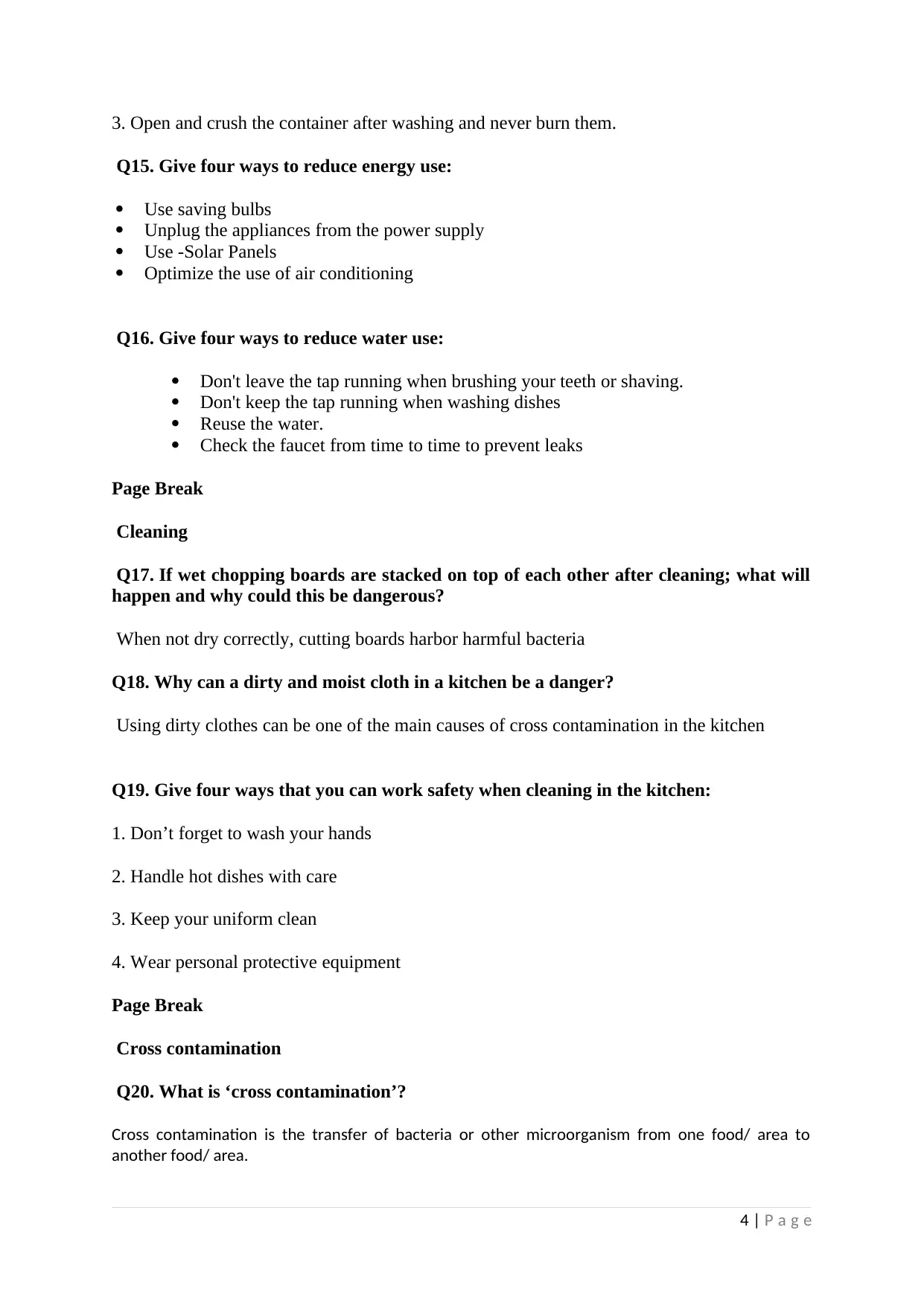
3. Open and crush the container after washing and never burn them.
Q15. Give four ways to reduce energy use:
Use saving bulbs
Unplug the appliances from the power supply
Use -Solar Panels
Optimize the use of air conditioning
Q16. Give four ways to reduce water use:
Don't leave the tap running when brushing your teeth or shaving.
Don't keep the tap running when washing dishes
Reuse the water.
Check the faucet from time to time to prevent leaks
Page Break
Cleaning
Q17. If wet chopping boards are stacked on top of each other after cleaning; what will
happen and why could this be dangerous?
When not dry correctly, cutting boards harbor harmful bacteria
Q18. Why can a dirty and moist cloth in a kitchen be a danger?
Using dirty clothes can be one of the main causes of cross contamination in the kitchen
Q19. Give four ways that you can work safety when cleaning in the kitchen:
1. Don’t forget to wash your hands
2. Handle hot dishes with care
3. Keep your uniform clean
4. Wear personal protective equipment
Page Break
Cross contamination
Q20. What is ‘cross contamination’?
Cross contamination is the transfer of bacteria or other microorganism from one food/ area to
another food/ area.
4 | P a g e
Q15. Give four ways to reduce energy use:
Use saving bulbs
Unplug the appliances from the power supply
Use -Solar Panels
Optimize the use of air conditioning
Q16. Give four ways to reduce water use:
Don't leave the tap running when brushing your teeth or shaving.
Don't keep the tap running when washing dishes
Reuse the water.
Check the faucet from time to time to prevent leaks
Page Break
Cleaning
Q17. If wet chopping boards are stacked on top of each other after cleaning; what will
happen and why could this be dangerous?
When not dry correctly, cutting boards harbor harmful bacteria
Q18. Why can a dirty and moist cloth in a kitchen be a danger?
Using dirty clothes can be one of the main causes of cross contamination in the kitchen
Q19. Give four ways that you can work safety when cleaning in the kitchen:
1. Don’t forget to wash your hands
2. Handle hot dishes with care
3. Keep your uniform clean
4. Wear personal protective equipment
Page Break
Cross contamination
Q20. What is ‘cross contamination’?
Cross contamination is the transfer of bacteria or other microorganism from one food/ area to
another food/ area.
4 | P a g e
Paraphrase This Document
Need a fresh take? Get an instant paraphrase of this document with our AI Paraphraser
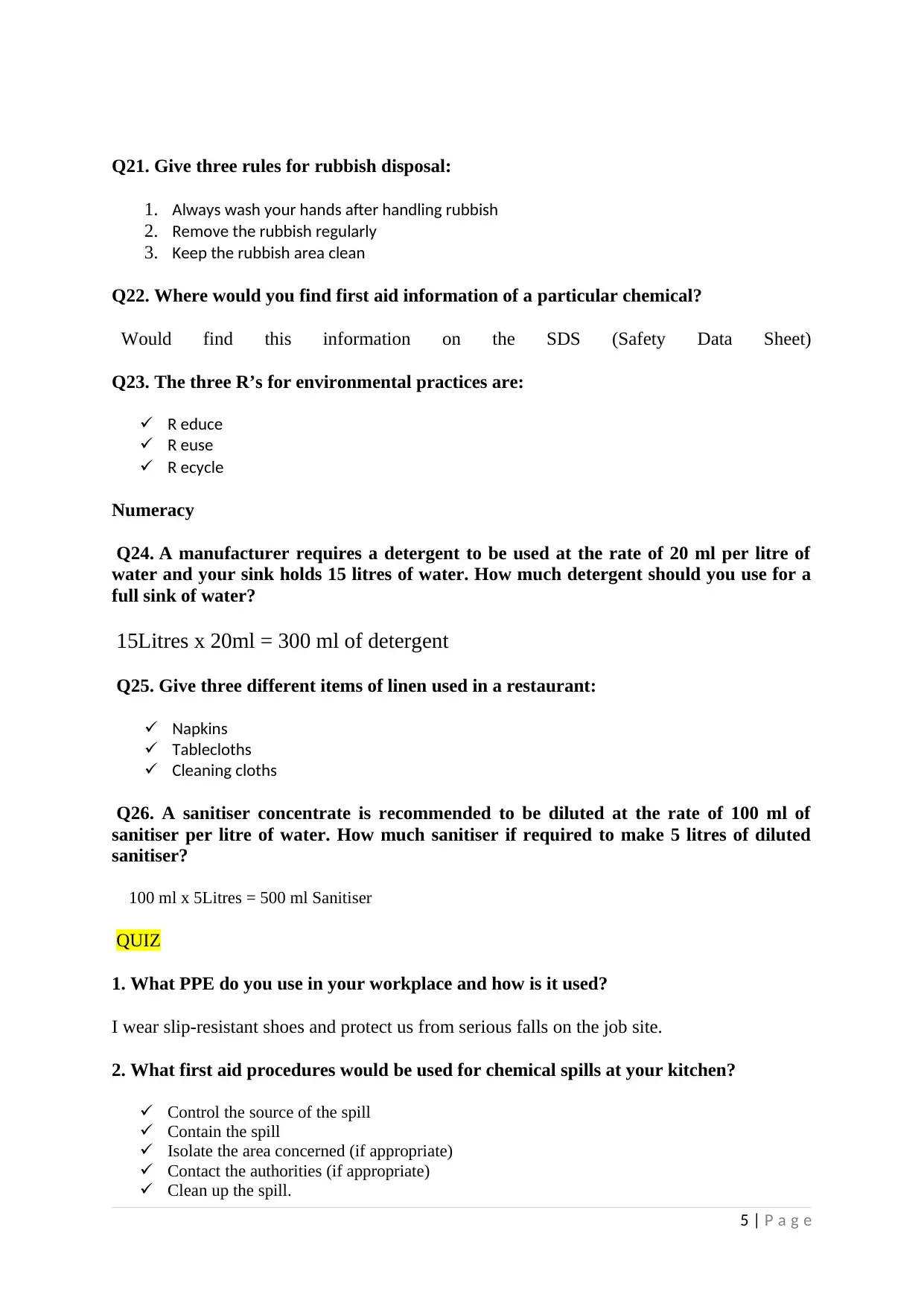
Q21. Give three rules for rubbish disposal:
1. Always wash your hands after handling rubbish
2. Remove the rubbish regularly
3. Keep the rubbish area clean
Q22. Where would you find first aid information of a particular chemical?
Would find this information on the SDS (Safety Data Sheet)
Q23. The three R’s for environmental practices are:
R educe
R euse
R ecycle
Numeracy
Q24. A manufacturer requires a detergent to be used at the rate of 20 ml per litre of
water and your sink holds 15 litres of water. How much detergent should you use for a
full sink of water?
15Litres x 20ml = 300 ml of detergent
Q25. Give three different items of linen used in a restaurant:
Napkins
Tablecloths
Cleaning cloths
Q26. A sanitiser concentrate is recommended to be diluted at the rate of 100 ml of
sanitiser per litre of water. How much sanitiser if required to make 5 litres of diluted
sanitiser?
100 ml x 5Litres = 500 ml Sanitiser
QUIZ
1. What PPE do you use in your workplace and how is it used?
I wear slip-resistant shoes and protect us from serious falls on the job site.
2. What first aid procedures would be used for chemical spills at your kitchen?
Control the source of the spill
Contain the spill
Isolate the area concerned (if appropriate)
Contact the authorities (if appropriate)
Clean up the spill.
5 | P a g e
1. Always wash your hands after handling rubbish
2. Remove the rubbish regularly
3. Keep the rubbish area clean
Q22. Where would you find first aid information of a particular chemical?
Would find this information on the SDS (Safety Data Sheet)
Q23. The three R’s for environmental practices are:
R educe
R euse
R ecycle
Numeracy
Q24. A manufacturer requires a detergent to be used at the rate of 20 ml per litre of
water and your sink holds 15 litres of water. How much detergent should you use for a
full sink of water?
15Litres x 20ml = 300 ml of detergent
Q25. Give three different items of linen used in a restaurant:
Napkins
Tablecloths
Cleaning cloths
Q26. A sanitiser concentrate is recommended to be diluted at the rate of 100 ml of
sanitiser per litre of water. How much sanitiser if required to make 5 litres of diluted
sanitiser?
100 ml x 5Litres = 500 ml Sanitiser
QUIZ
1. What PPE do you use in your workplace and how is it used?
I wear slip-resistant shoes and protect us from serious falls on the job site.
2. What first aid procedures would be used for chemical spills at your kitchen?
Control the source of the spill
Contain the spill
Isolate the area concerned (if appropriate)
Contact the authorities (if appropriate)
Clean up the spill.
5 | P a g e
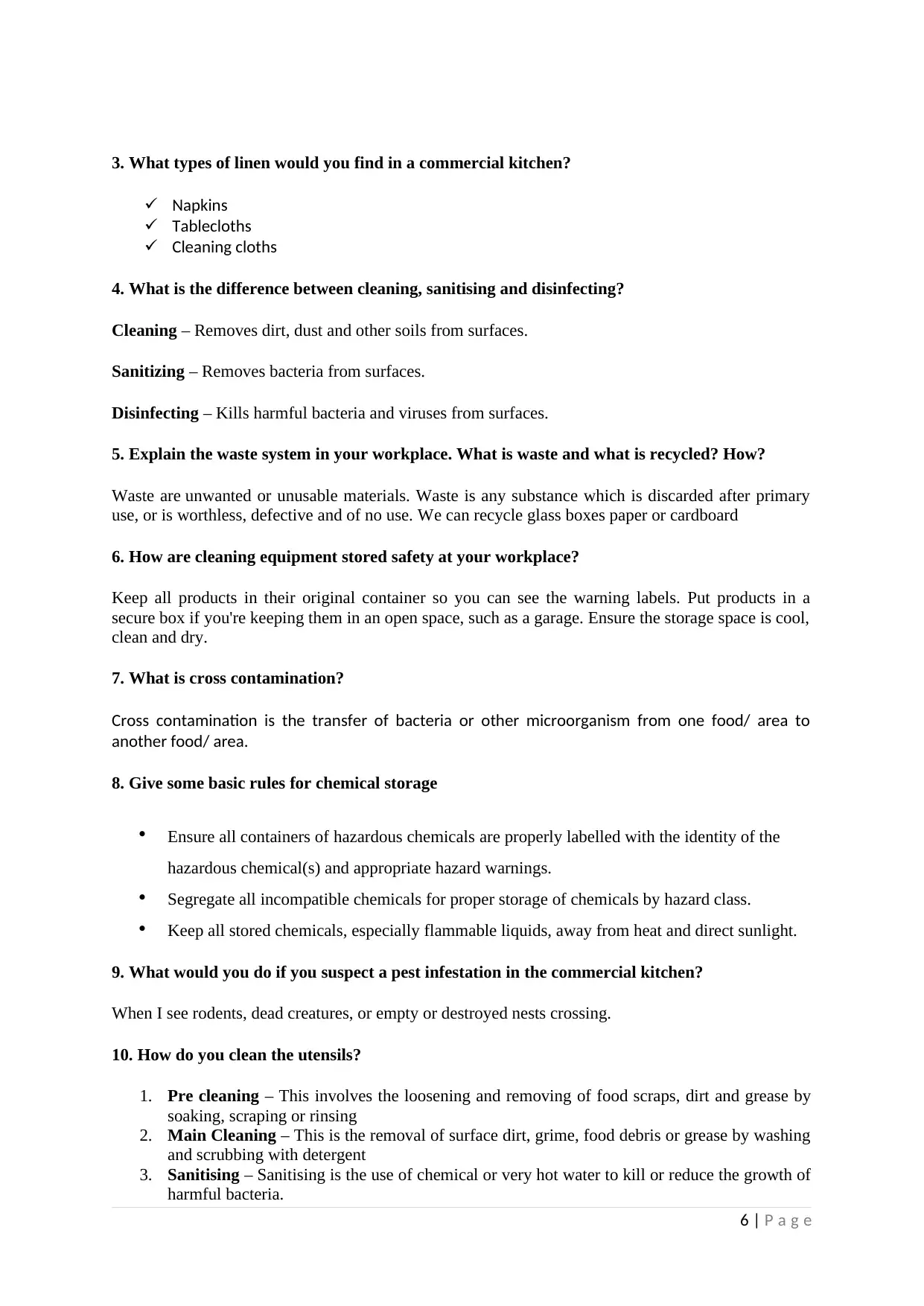
3. What types of linen would you find in a commercial kitchen?
Napkins
Tablecloths
Cleaning cloths
4. What is the difference between cleaning, sanitising and disinfecting?
Cleaning – Removes dirt, dust and other soils from surfaces.
Sanitizing – Removes bacteria from surfaces.
Disinfecting – Kills harmful bacteria and viruses from surfaces.
5. Explain the waste system in your workplace. What is waste and what is recycled? How?
Waste are unwanted or unusable materials. Waste is any substance which is discarded after primary
use, or is worthless, defective and of no use. We can recycle glass boxes paper or cardboard
6. How are cleaning equipment stored safety at your workplace?
Keep all products in their original container so you can see the warning labels. Put products in a
secure box if you're keeping them in an open space, such as a garage. Ensure the storage space is cool,
clean and dry.
7. What is cross contamination?
Cross contamination is the transfer of bacteria or other microorganism from one food/ area to
another food/ area.
8. Give some basic rules for chemical storage
Ensure all containers of hazardous chemicals are properly labelled with the identity of the
hazardous chemical(s) and appropriate hazard warnings.
Segregate all incompatible chemicals for proper storage of chemicals by hazard class.
Keep all stored chemicals, especially flammable liquids, away from heat and direct sunlight.
9. What would you do if you suspect a pest infestation in the commercial kitchen?
When I see rodents, dead creatures, or empty or destroyed nests crossing.
10. How do you clean the utensils?
1. Pre cleaning – This involves the loosening and removing of food scraps, dirt and grease by
soaking, scraping or rinsing
2. Main Cleaning – This is the removal of surface dirt, grime, food debris or grease by washing
and scrubbing with detergent
3. Sanitising – Sanitising is the use of chemical or very hot water to kill or reduce the growth of
harmful bacteria.
6 | P a g e
Napkins
Tablecloths
Cleaning cloths
4. What is the difference between cleaning, sanitising and disinfecting?
Cleaning – Removes dirt, dust and other soils from surfaces.
Sanitizing – Removes bacteria from surfaces.
Disinfecting – Kills harmful bacteria and viruses from surfaces.
5. Explain the waste system in your workplace. What is waste and what is recycled? How?
Waste are unwanted or unusable materials. Waste is any substance which is discarded after primary
use, or is worthless, defective and of no use. We can recycle glass boxes paper or cardboard
6. How are cleaning equipment stored safety at your workplace?
Keep all products in their original container so you can see the warning labels. Put products in a
secure box if you're keeping them in an open space, such as a garage. Ensure the storage space is cool,
clean and dry.
7. What is cross contamination?
Cross contamination is the transfer of bacteria or other microorganism from one food/ area to
another food/ area.
8. Give some basic rules for chemical storage
Ensure all containers of hazardous chemicals are properly labelled with the identity of the
hazardous chemical(s) and appropriate hazard warnings.
Segregate all incompatible chemicals for proper storage of chemicals by hazard class.
Keep all stored chemicals, especially flammable liquids, away from heat and direct sunlight.
9. What would you do if you suspect a pest infestation in the commercial kitchen?
When I see rodents, dead creatures, or empty or destroyed nests crossing.
10. How do you clean the utensils?
1. Pre cleaning – This involves the loosening and removing of food scraps, dirt and grease by
soaking, scraping or rinsing
2. Main Cleaning – This is the removal of surface dirt, grime, food debris or grease by washing
and scrubbing with detergent
3. Sanitising – Sanitising is the use of chemical or very hot water to kill or reduce the growth of
harmful bacteria.
6 | P a g e
⊘ This is a preview!⊘
Do you want full access?
Subscribe today to unlock all pages.

Trusted by 1+ million students worldwide
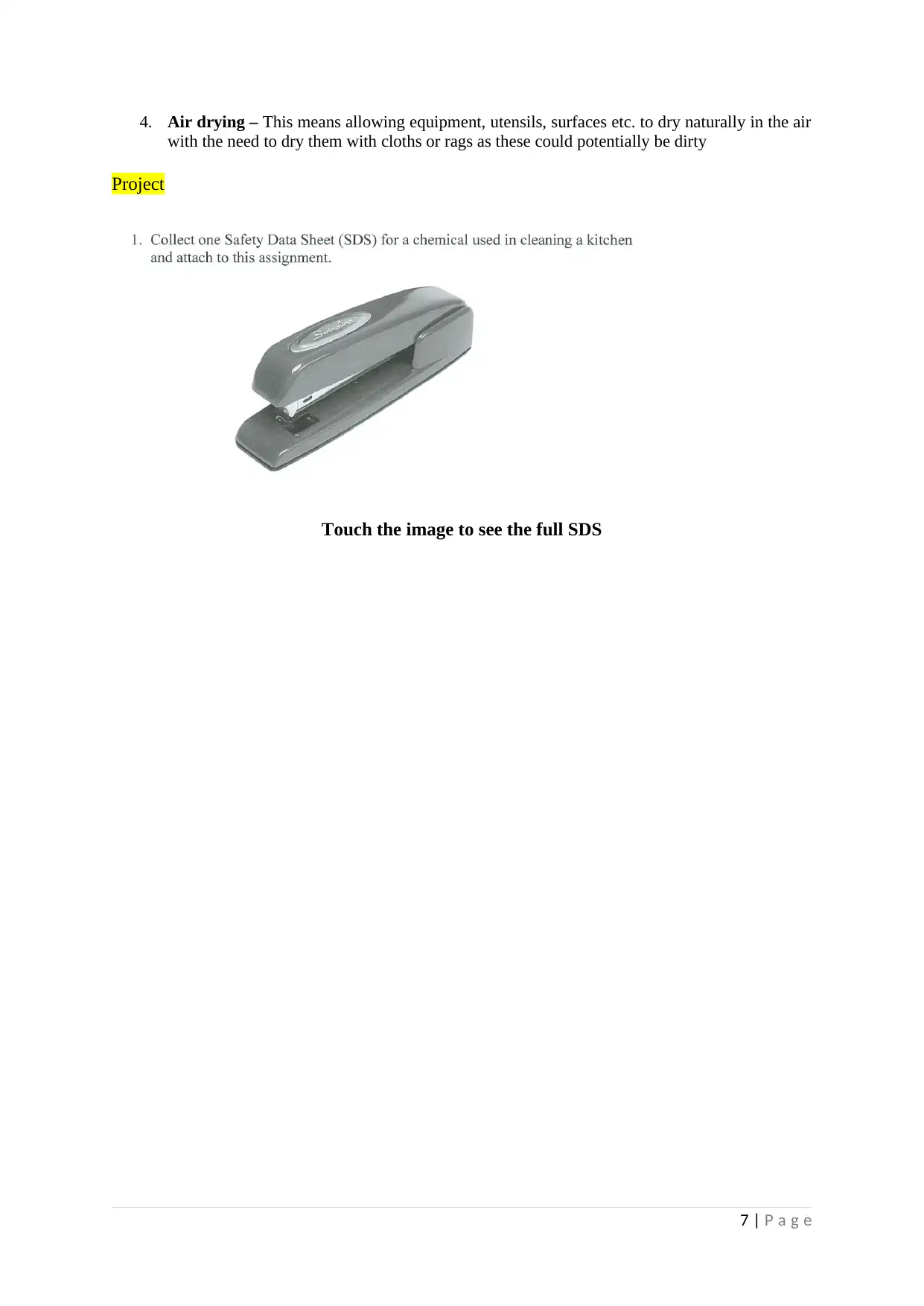
4. Air drying – This means allowing equipment, utensils, surfaces etc. to dry naturally in the air
with the need to dry them with cloths or rags as these could potentially be dirty
Project
Touch the image to see the full SDS
7 | P a g e
with the need to dry them with cloths or rags as these could potentially be dirty
Project
Touch the image to see the full SDS
7 | P a g e
Paraphrase This Document
Need a fresh take? Get an instant paraphrase of this document with our AI Paraphraser
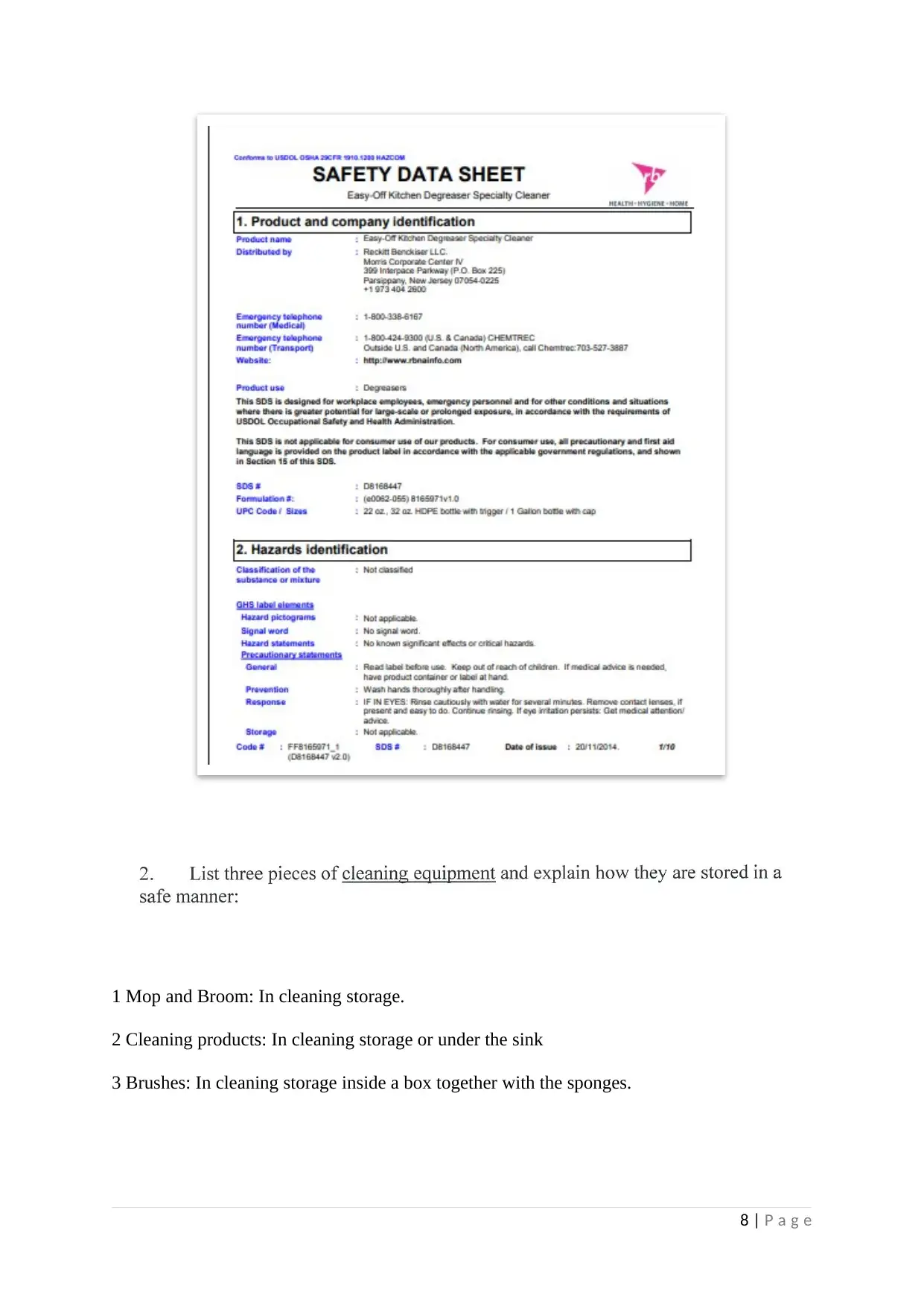
1 Mop and Broom: In cleaning storage.
2 Cleaning products: In cleaning storage or under the sink
3 Brushes: In cleaning storage inside a box together with the sponges.
8 | P a g e
2 Cleaning products: In cleaning storage or under the sink
3 Brushes: In cleaning storage inside a box together with the sponges.
8 | P a g e
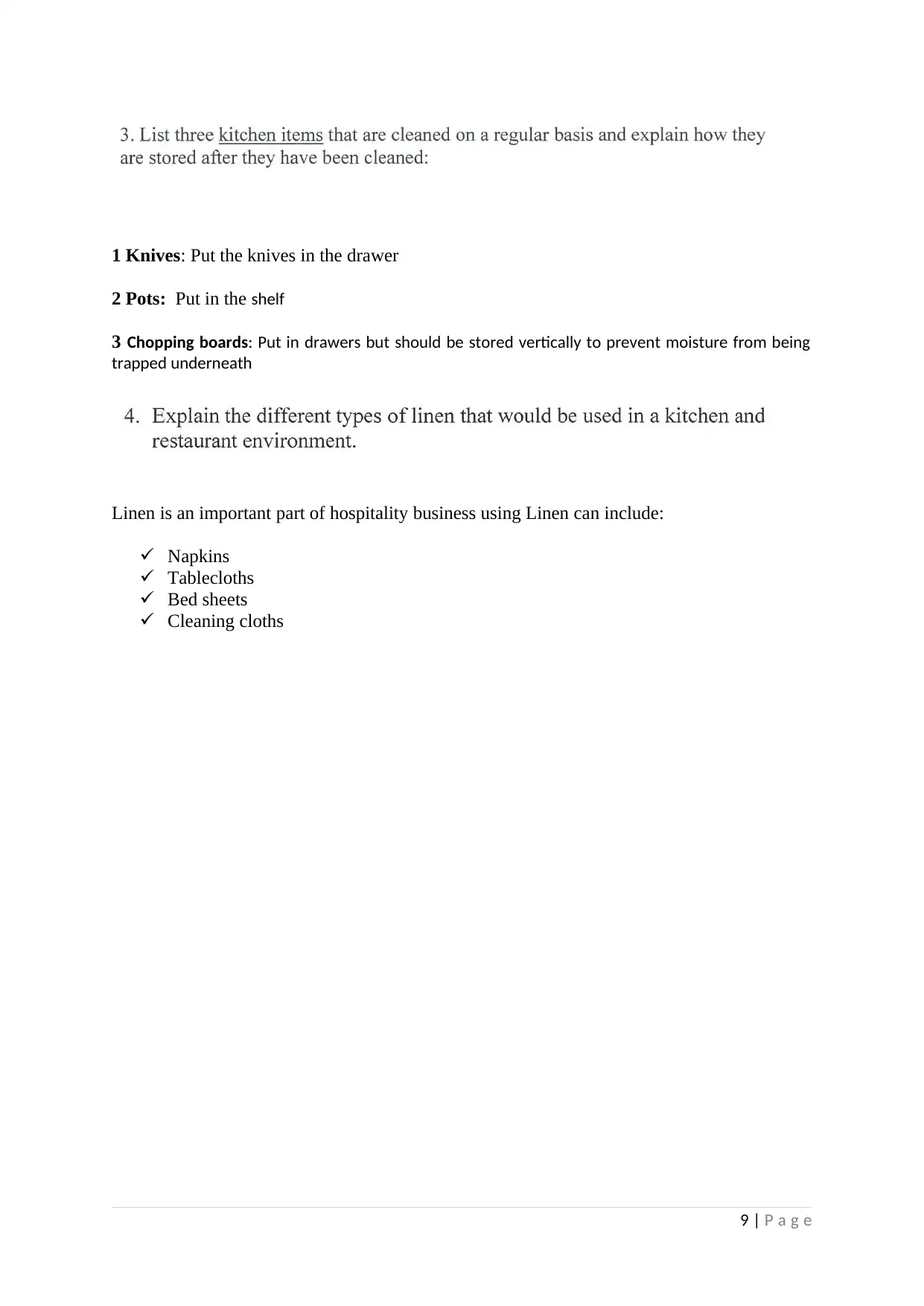
1 Knives: Put the knives in the drawer
2 Pots: Put in the shelf
3 Chopping boards: Put in drawers but should be stored vertically to prevent moisture from being
trapped underneath
Linen is an important part of hospitality business using Linen can include:
Napkins
Tablecloths
Bed sheets
Cleaning cloths
9 | P a g e
2 Pots: Put in the shelf
3 Chopping boards: Put in drawers but should be stored vertically to prevent moisture from being
trapped underneath
Linen is an important part of hospitality business using Linen can include:
Napkins
Tablecloths
Bed sheets
Cleaning cloths
9 | P a g e
⊘ This is a preview!⊘
Do you want full access?
Subscribe today to unlock all pages.

Trusted by 1+ million students worldwide
1 out of 9
Your All-in-One AI-Powered Toolkit for Academic Success.
+13062052269
info@desklib.com
Available 24*7 on WhatsApp / Email
![[object Object]](/_next/static/media/star-bottom.7253800d.svg)
Unlock your academic potential
Copyright © 2020–2025 A2Z Services. All Rights Reserved. Developed and managed by ZUCOL.